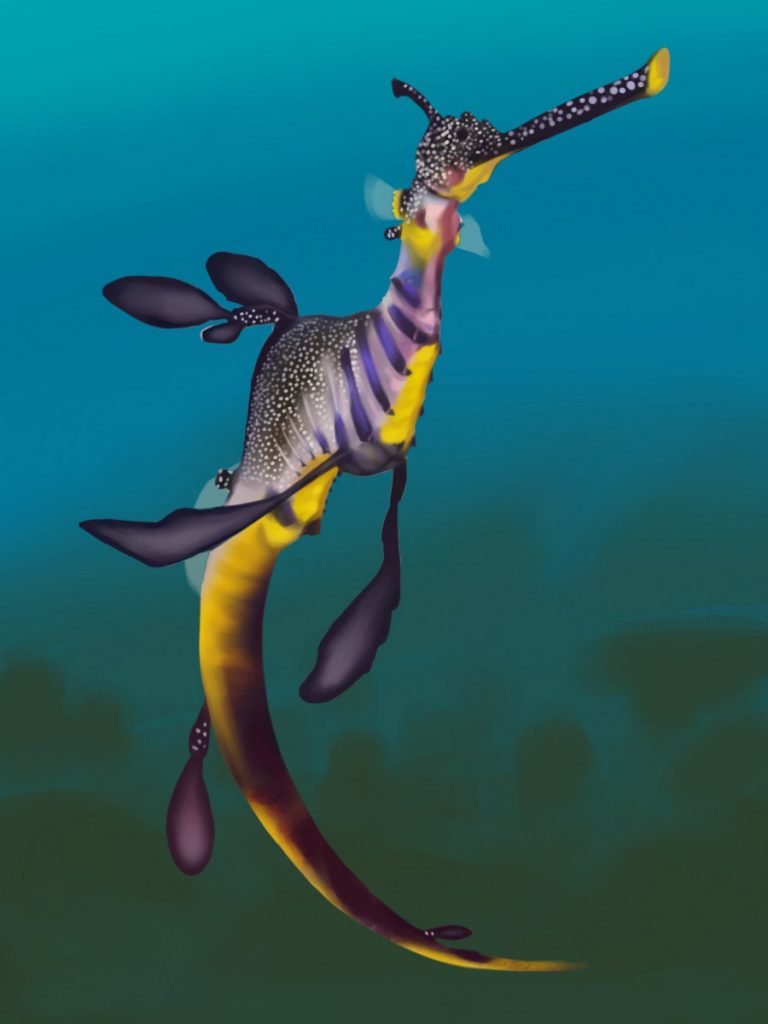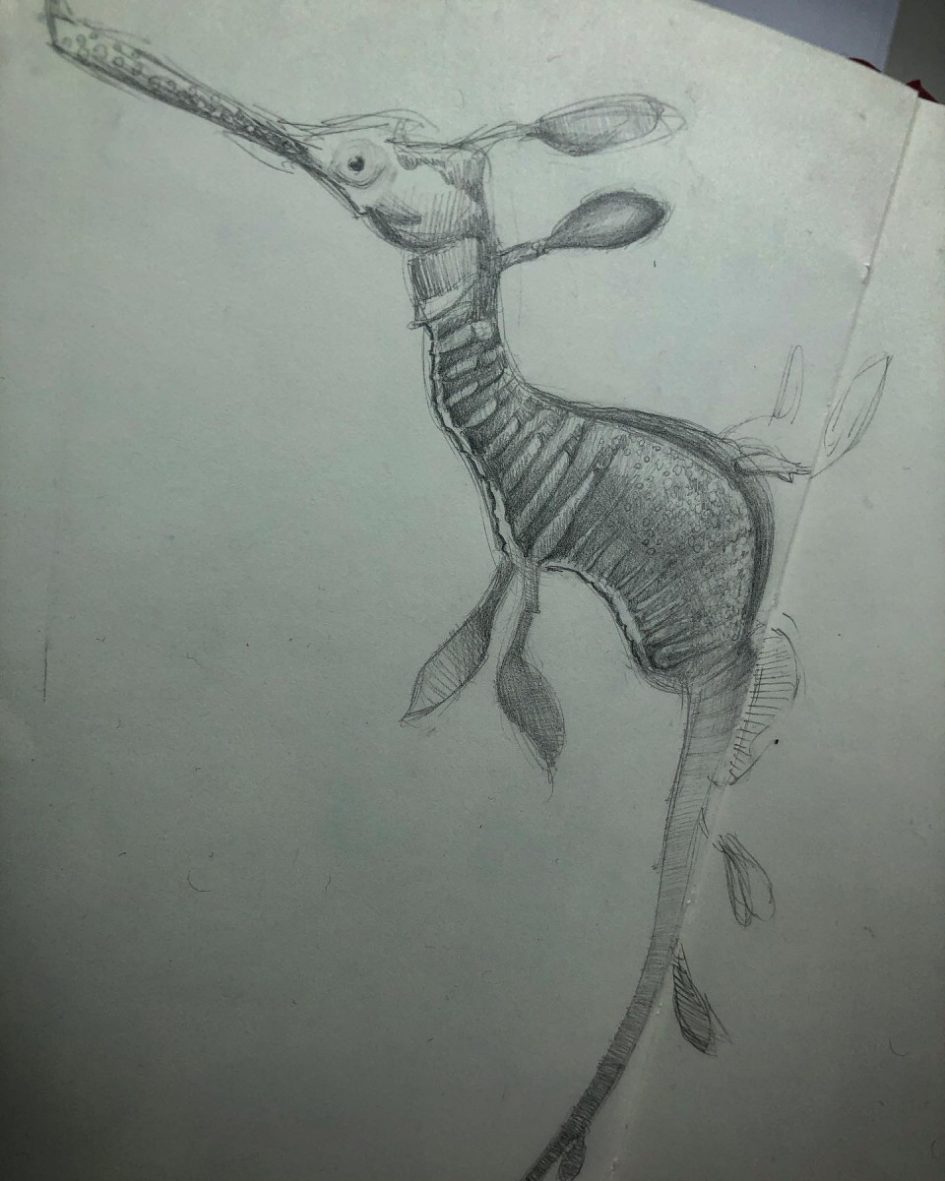By Yukim Nomoto

The Phyllopteryx taeniolatus, also known as the weedy sea dragon or common sea dragon, is part of the Syngnathidae family. Their most recognizable feature is their long, thin snout, which is shared among their taxonomy family members, like seahorses and pipefish. However, unlike seahorses, these common sea dragons’ tails are not prehensile. These organisms have weed-like appendages for fins down the back of their bony, slender body, resembling sea vegetation, which they use to camouflage themselves in seaweed for protection. Although they may resemble the muted weeds of its habitat, weedy sea dragons are adorned in vibrant patterns of reds, yellows, and purples. We have seen other pigment variations, including more green, yellow, or blue weedy sea dragons. They have small, transparent pectoral fins on their necks for body positioning and another transparent dorsal fin for propulsion.
Although the weedy sea dragons have locomotion like propulsion with their fins, they are not exactly the most proficient swimmers. Their rigid, skeletal body— just like the seahorses’— hinders their mobility and slows them down. Their locomotion consists of propulsion by “rapidly oscillating their ventral and dorsal fins” (Aquarium). They propel themselves by using their tail as a rudder with their fins. To move vertically, “they change the amount of air in their floatation or air bladders” (Aquarium). A study observed a weedy sea dragon traveling at up to 150 meters per hour. While these species have their methods of traveling, they are often seen being static. They often drift along the water day and night, between kelp leaves and coral reefs, seeming quite content with it. Another study showed weedy sea dragons to have been observed remaining in the same location for up to 68 hours.
The weedy sea dragons are part of the Syngnathidae family, which includes all species of pipefish, seahorses, sea dragons, and pipe horses. There are more than 340 recognized species in more than 50 genera in this family taxonomy, distributed in marine tropical to temperate water globally. All Syngnathidae family members have “a tiny mouth at the end of a tubular snout and semi-flexible bodies encased in bony rings” (Bray 2019). They are carnivores, primarily feasting on “small benthic and pelagic crustaceans like copepods, amphipods, mysids, and shrimps” using their long snout to powerfully suck prey rapidly (Bray 2019). Syngnathids lack fin and pelvic spines, and other fins are reduced or absent compared to most marine species with fins. These taxonomic relatives are unique because their reproductive mode involves “the female [depositing] her eggs into an abdominal brood pouch or onto a modified exposed region on the underside of her male partner” (Bray 2019). The male carrying the eggs then “incubates and nourishes the developing embryos until they hatch” and are released into the water after about 4 to 6 weeks (Bray 2019). As mentioned previously, just like the weedy sea dragons, these fish are often “ornamented with filaments and other appendages to enhance their excellent camouflage” (Bray 2019).
Weedy sea dragons are native to the southern coast of Australia, including Tasmania, southern Indian Ocean, and the southwest Pacific. They live in waters with temperatures between 12 to 23 degrees Celsius, often found in the depth of around 8 to 12 meters of water while many others live in a depth range of 10 to 50 meters. They inhabit “kelp forests, on rocky reefs, and seaweed or seagrass beds” (MarineBio).

Umwelt
The umwelt of the Australian coast native, the weedy sea dragons,
is affected by the water temperature of its habitat which affects the sea vegetation. These species rely on seaweeds as homes and drift about them with the water and vegetation as camouflage. They are often swimming on the sea bed in pairs or alone, picking up small crustaceans, sea lice, fish larvae, etc. with their long, straw-like snouts. Their entire world is of the kelp forests and seagrass beds. They are worry-free as they go with the flow, riding the momentum of the waters day and night.
Work Cited
Aquarium of the Pacific. “Weedy Seadragon.” Online Learning Center | Weedy Seadragon, www.aquariumofpacific.org/onlinelearningcenter/species/weedy_seadragon1.
Bray, D.J. 2019, Seahorses, pipefishes, SYNGNATHIDAE in Fishes of Australia, accessed 13 May 2020, https://fishesofaustralia.net.au/home/family/34#moreinfo.
“Leafy Seadragon.” Oceana, 1 May 1970, oceana.org/marine-life/ocean-fishes/leafy-seadragon.
“Weedy Sea Dragon.” National Geographic, 21 Sept. 2018, www.nationalgeographic.com/animals/fish/w/weedy-sea-dragon/.
“Weedy Sea Dragons ~ MarineBio Conservation Society.” MarineBio Conservation Society, 7 Mar. 2020, marinebio.org/species/weedy-sea-dragons/phyllopteryx-taeniolatus/ .

